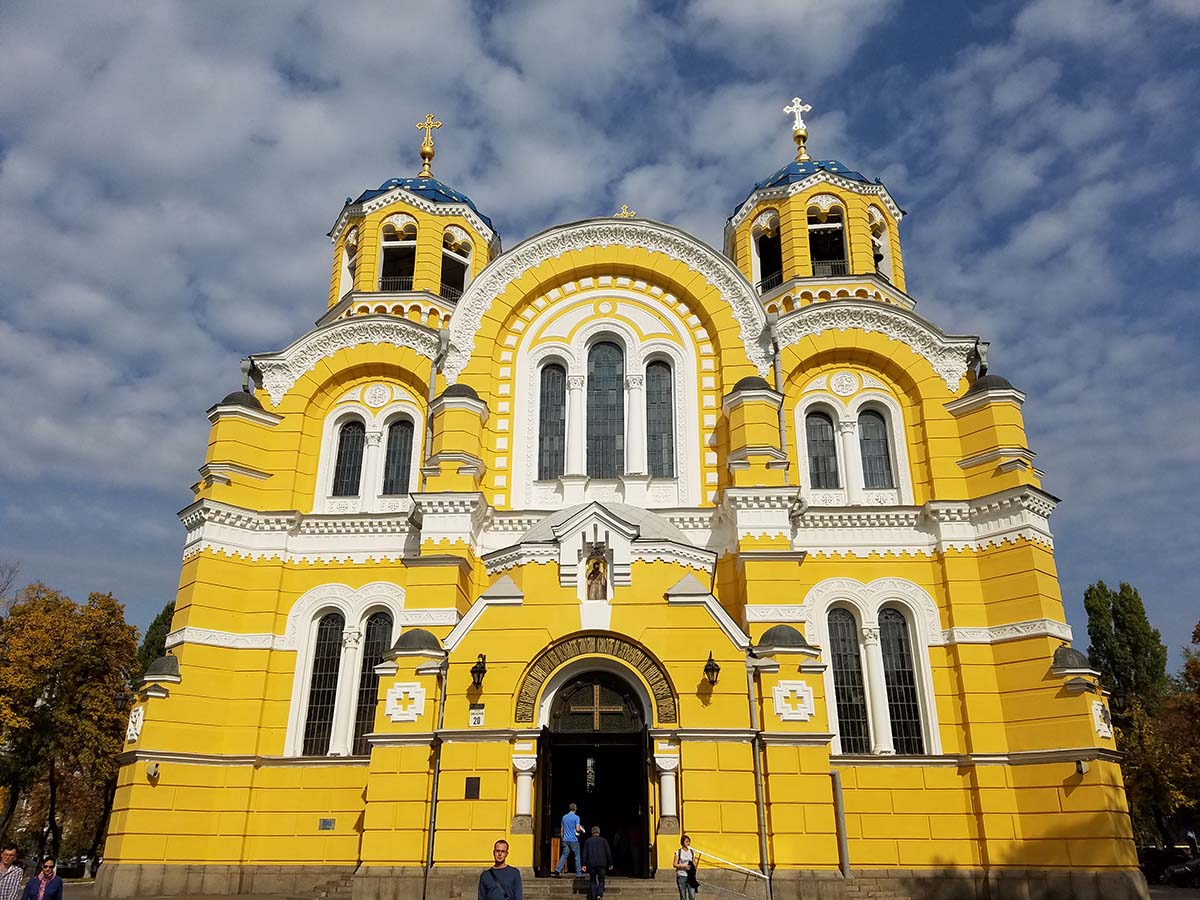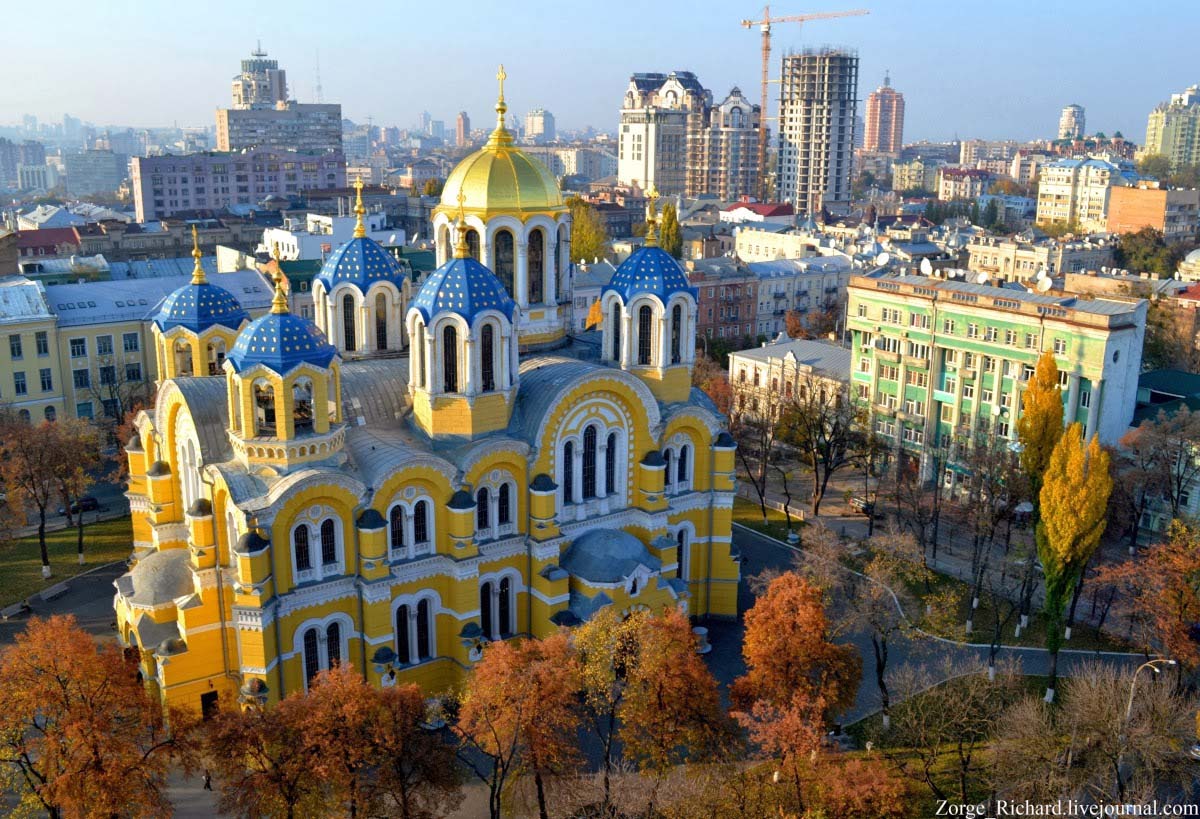In 1852, the Kiev Metropolitan, in his letter to Emperor Nicholas the First, expressed the idea of the need to build a temple in Kyiv, which would be a monument to the Grand Duke of Kyiv Vladimir Svyatoslavich. In July 1853, the emperor approved the report of the Holy Synod on the construction of a cathedral church in Kyiv in the name of the Holy Equal-to-the-Apostles Prince Vladimir, and already in August a construction committee was created, which included mainly clergy. It was decided that the temple would be built exclusively from charitable donations. The design of the temple was entrusted to the architect Ivan Shtrom.
After the death of the Metropolitan in 1857, the number of donations decreased significantly. The new metropolitan, although not as active as his predecessor, monitored the construction of the temple. He ensured that a plot of land was allocated for its construction near the Kyiv University of St. Vladimir (now Taras Shevchenko), although previously the plot was allocated within the city of Yaroslav (Starokievskaya Gora). In 1859, Ivan Shtrom submitted drawings of the cathedral to the construction committee for consideration. The cathedral was designed in the neo-Byzantine style and was based on a cross. The cathedral was to be crowned with 13 golden domes. The construction committee, having reviewed and approved the project, sent the drawings to St. Petersburg, where Alexander II personally approved it.
In March 1860, a site was planned for the construction of the cathedral church. Given the shortage of funds, the construction committee instructed the diocesan architect Pavel Sparro to rework Ivan Shtrom’s design in order to reduce the size of the structure and the estimate for its construction. Sparro, in order not to completely redo the project, decided to remove the side naves, that is, change the cruciform base. Instead of 13 domes, he left 7. The construction committee entrusted direct supervision of construction to Alexander Beretti (designed anatomical theater building), which made significant changes to the Strohm-Sparro project. In July 1862, on the day of the celebration of the memory of Prince Vladimir, the first stone of the future temple was laid.
Already in 1866, the Vladimir Cathedral was built up to the domes. However, unexpectedly the walls, and after them the arches and ceilings, showed deep cracks. It became clear that they would not withstand the weight of the domes… The work was stopped, a special technical committee was created from leading Kyiv architects, and Ivan Shtrom was called from St. Petersburg. It turned out that the situation was caused by errors made in the mathematical calculations of Alexander Beretti during the reworking of the project, who was immediately suspended. When Emperor Alexander II came to Kyiv in 1875, while inspecting the city, he inquired about the construction of a cathedral church. Seeing an empty construction site and completely rotten scaffolding, he ordered the work to continue at any cost. One of the most famous architects, Rudolf Bernhard, was immediately called from St. Petersburg, who made accurate mathematical calculations of the loads on the walls and ceilings, and then found a technical solution for eliminating the cracks. It was proposed to strengthen the external load-bearing walls by adding side naves and buttresses.
In June 1876, construction work was resumed, headed by the Kiev architect Vladimir Nikolaev (Ascension Church, Tereshchenko mansion, mansion Lieberman, National Philharmonic, monument to Khmelnitsky). He developed designs for the side naves. Inside, the temple was divided into three naves: the middle one and two side ones, and they, in turn, were divided by choirs into two unequal parts. The roundness of the structure was provided by apses that corresponded to the width of the internal naves. It was planned to have five vestibules in the cathedral (three at the bottom and two at the choir). However, according to Byzantine traditions, it was decided that in the Vladimir Cathedral there would be one altar in the middle nave, the altar on the right, and the sacristy on the left. Two more altars – Olginsky and Borisoglebsky – were supposed to be in the choir.
In 1882, the twenty-year construction of St. Vladimir’s Cathedral was completed. In the spring of 1896, the painting and finishing of the cathedral were practically completed, with the exception of the Olginsky and Borisoglebsky chapels in the choirs. On September 1, 1896, in the presence of the imperial family, dignitaries, high clergy and clergy, Metropolitan Ioannikis of Kiev consecrated St. Vladimir’s Cathedral. In 1929, the All-Ukrainian Central Executive Committee approved the decision to close the cathedral and turn the temple into a museum of anti-religious propaganda. For some time, the archival funds of local authorities were located here, then the book depository of the pedagogical institute.
During the occupation, St. Vladimir’s Cathedral was restored, its solemn consecration was planned for the end of 1943. After the liberation of Kyiv and in 1944 it became the cathedral church of the Metropolitan of Kyiv and Galicia, Exarch of Ukraine. In 1995, a council of the Ukrainian Orthodox Church of the Kyiv Patriarchate was held in the St. Vladimir Church, at which Metropolitan Philaret was elected Patriarch of Kyiv and All Rus’-Ukraine. This council was not recognized by any of the Local Orthodox Churches.
Where is St. Vladimir Cathedral?
Taras Shevchenko Boulevard, 20
06:30 – 19:30
044 235 5385



